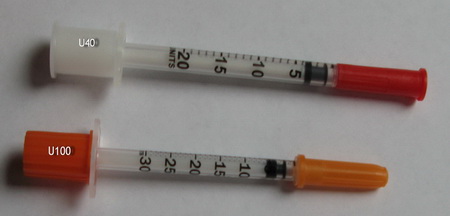 |
The top photo is a U40 syringe which come with red caps
and needles covers, and are also available with red unit marks. U40
syringes are made to hold 20.0u of U40 insulin or less, and are
difficult to find with half unit marks. U40 insulin must be used
with U40 syringes.
We recommend using the syringe in the
bottom of the photo which is a 3/10cc
(ml) 100 syringe, for use with 30.0 units or less of U100 insulin.
They have orange caps and needle covers. U100 syringes come with
both full and half unit marks. Syringes with half unit marks make measuring
the small increments given on TR much easier and more accurate. If from Europe, the description is 3/10ml, for 30
units or less, demi (descriptor for half unit markings).
The cc and ml unit of measurement is the same. U100 syringes can
be utilized with U40 insulin by using the
conversion
chart.
|
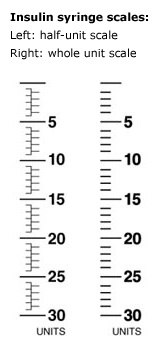 |
Half unit marks make for much easier measuring of half and
quarter units, as well as the "fats and skinnies" we use when
dosing our cats on TR. Most vets do not support the use of U100 syringes
with U40 insulin. Using the
conversion
chart for U40 insulin and U100 syringes, we are able to much more
accurately measure very small increments of insulin.
Most U40 insulin syringes do not have half unit marks, so accurate
and consistent measuring of small doses is far more difficult.
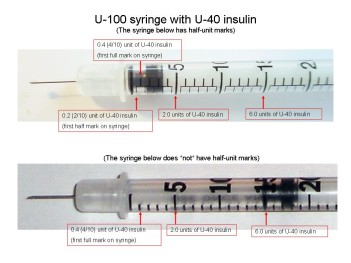
For more information,
click
here.
|
 |
The gauge of U100 syringes varies from 25 gauge (thickest)
to 33 gauge (thinnest). The most commonly found 3/10cc
syringes with half unit marks are found in gauges 29, 30 or 31.
While a thinner gauge needle may hurt less during injection, the thinner the gauge, the more chance the needle may bend when giving
shots. |
 |
The needles on insulin syringes come in two lengths,
1/2" (longs - left photo) or 5/16" (shorts - right photo).
Some people find short needles are sometimes easier to control. Longer needles tend to
work better for cats with a thicker layer of fat, getting in past the fat
layer for better insulin absorption. The choice to use longs
or shorts is generally a matter of personal preference. |
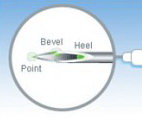 |
Many find there are better absorption results if the bevel
of the syringe is facing outwards when giving shots. Injecting
with the bevel side facing up/out allows for the needle to slide into
the skin much easier resulting in shots being less painful. For
more information
click
here. |
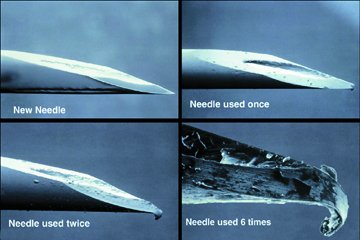 |
Insulin syringes are meant to be used one time only. In an
emergency, they can be cleaned with vigorous rubbing alcohol rinses, but
this is not recommended unless absolutely necessary. When the
needle is inserted, chunks of skin clog the needle; the tip of the
needle become blunt hurting more when injected into the skin. To
learn more about needles damaged by reuse, click
here. |
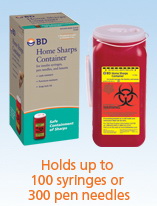 |
More than a billion insulin
syringes, needles, and lancets are used for diabetes care in the United
States alone each year. If they are not disposed of properly, these
items, known as "sharps", can injure other people.
The rules and regulations regarding sharps
disposal may be different in towns and counties around the world.
Please check with your local sanitation or health department for
information about how to dispose of used syringes properly.
|






